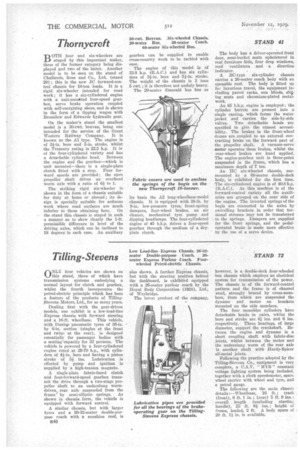Tilling-Stevens
Page 184

If you've noticed an error in this article please click here to report it so we can fix it.
ONLY four vehicles are shown on this stand, three of which have transmission systems embodying a normal layout for clutch and gearbox, whilst the fourth incorporates the petrol-electric principle which has been a feature of the products of TillingStevens Motors, Ltd., for so many years.
Dealing first with the gear-driven models, one exhibit is a low-load-line Express chassis with forward steering and a 16-ft. wheelbase. This vehicle, with Dunlep pneumatic tyres of 36-in. by 6-in. section (singles at the front and twins at the rear), is designed essentially for passenger bodies with a seating 'capacity for 32 persons. The vehicle is powered by a four-cylindered engine rated at 29-70 h.p., with cylinders of ft-in, bore and having a piston stroke of 53 ins. Lubrication is effected by pump and ignition is supplied by a high-tension magneto.
A single-plate fabric-faced clutch and four-forward-speed gearbox transmit the drive through a two-stage propeller shaft to an underslung wormdriven rear axle suspended from the frame' by semi-elliptic springs. As shown in chassis_ form, the vehicle is equipped with forward control.
A similar chassis, but with larger tyres and a 26-32-seater double-purpose coach with a sunshine roof, is
H46 also shown. A further Express chassis, but with the steering position behind the dashboard, is exhibited equipped with a 26-seater parlour coach by the Hoyal Body Corporation (1928), Ltd., of Weybridge.
The latest product of the company. however, is a double-deck four-wheeled bus chassis which employs an electrical system for transmission of the power. The chassis is of the forward-control pattern and the frame is of channel steel, strongly braced by cross-members, from which are suspended the dynamo and motor on brackets mounted on the side members.
The four monobloc cylinders have detachable heads in pairs, whilst the bore and stroke are 4i ins. and 6 ins. respectively. Three bearings, of large diameter, support the crankshaft. Between the engine and dynamo is a short coupling shaft with fabric-disc joints, whilst between the motor and the underslung worm of the rear axle is another shaft with Hardy-Spicer all-metal joints.
Following the practice adopted by the Tilling-Stevens Co., equipment is very complete, a C.A.V. " MYR " constant voltage lighting system being included, together with a clock speedometer, spare wheel carrier with wheel and tyre, and a petrol gauge.
The following are the main chassis details :—Wheelbase, 16 ft.; track (front), 6 ft. 1 in.; (rear) 5 ft. 9 ins.; overall length (excluding starting handle), 25 ft. 63ins.; height of frame, loaded, 2 ft. A body space of 20 ft. 13 in. is available.








































































































































































































































































































































